Evaluation of Lower-Limb Kinematics during Timed Up and Go (TUG) Test in Subjects with Locomotive Syndrome (LS) Using Wearable Gait Sensors (H-Gait System)
Abstract
1. Introduction
2. Materials and Methods
2.1. Participants
2.2. The LS Risk Test
2.3. TUG Test Using the Motion Analysis System
2.4. Data Analysis Using the H-Gait System
2.5. TUG Subtasks
2.6. Statistical Analysis
3. Results
3.1. Demography, TUG Completion Time, and Duration of TUG Subtasks
3.2. Lower-Limb Kinematics during the TUG Test
4. Discussion
5. Conclusions
Author Contributions
Funding
Institutional Review Board Statement
Informed Consent Statement
Data Availability Statement
Conflicts of Interest
References
- Nakamura, K. A ‘super-aged’ society and the ‘locomotive syndrome’. J. Orthop. Sci. 2008, 13, 1. [Google Scholar] [CrossRef] [PubMed]
- Yoshimura, N.; Muraki, S.; Oka, H.; Mabuchi, A.; En-Yo, Y.; Yoshida, M.; Saika, A.; Yoshida, H.; Suzuki, T.; Yamamoto, S.; et al. Prevalence of knee osteoarthritis, lumbar spondylosis, and osteoporosis in Japanese men and women: The research on osteoarthritis/osteoporosis against disability study. J. Bone Miner. Metab. 2009, 27, 620–628. [Google Scholar] [CrossRef] [PubMed]
- Locomotive Challenge Council, Japanese Orthopaedic Association. Locomotive Syndrome Pamphlet. 2015. Available online: https://locomo-joa.jp/assets/pdf/index_english (accessed on 15 November 2022).
- Yamada, K.; Ito, Y.M.; Akagi, M.; Chosa, E.; Fuji, T.; Hirano, K.; Ikeda, S.; Ishibashi, H.; Ishibashi, Y.; Ishijima, M.; et al. Reference values for the locomotive syndrome risk test quantifying mobility of 8681 adults aged 20–89 years: A cross-sectional nationwide study in Japan. J. Orthop. Sci. 2020, 25, 1084–1092. [Google Scholar] [CrossRef] [PubMed]
- Nakamura, K.; Ogata, T. Locomotive syndrome: Definition and management. Clin. Rev. Bone Miner. Metab. 2016, 14, 56–67. [Google Scholar] [CrossRef]
- Tadano, S.; Takeda, R.; Sasaki, K.; Fujisawa, T.; Tohyama, H. Gait characterization for osteoarthritis patients using wearable gait sensors (H-Gait systems). J. Biomech. 2016, 49, 684–690. [Google Scholar] [CrossRef]
- Kataoka, Y.; Shimizu, T.; Takeda, R.; Tadano, S.; Saito, Y.; Osuka, S.; Ishida, T.; Samukawa, M.; Irie, T.; Takahashi, D.; et al. Effects of unweighting on gait kinematics during walking on a lower-body positive-pressure treadmill in patients with hip osteoarthritis. BMC Musculoskelet. Disord. 2021, 22, 46. [Google Scholar] [CrossRef]
- Kataoka, Y.; Takeda, R.; Tadano, S.; Ishida, T.; Saito, Y.; Osuka, S.; Samukawa, M.; Tohyama, H. Analysis of 3-D kinematics using H-Gait system during walking on a lower body positive pressure treadmill. Sensors 2021, 21, 2619. [Google Scholar] [CrossRef]
- Saito, Y.; Ishida, T.; Kataoka, Y.; Takeda, R.; Tadano, S.; Suzuki, T.; Nakamura, K.; Nakata, A.; Osuka, S.; Yamada, S.; et al. Evaluation of gait characteristics in subjects with locomotive syndrome using wearable gait sensors. BMC Musculoskelet. Disord. 2022, 23, 457. [Google Scholar] [CrossRef]
- Nishizawa, A.; Katsuhira, J.; Watanabe, M.; Fujii, T.; Yoshimoto, T.; Oka, H.; Matsudaira, K. Relationship between the locomotive syndrome and kinetic and kinematic parameters during static standing and level walking. Gait Posture 2022, 93, 146–152. [Google Scholar] [CrossRef]
- Podsiadlo, D.; Richardson, S. The timed “Up & Go”: A test of basic functional mobility for frail elderly persons. J. Am. Geriatr. Soc. 1991, 39, 142–148. [Google Scholar]
- Shumway-Cook, A.; Brauer, S.; Woollacott, M. Predicting the probability for falls in community dwelling older adults using the timed up & go test. Phys. Ther. 2000, 80, 896–903. [Google Scholar] [PubMed]
- Muramoto, A.; Imagama, S.; Ito, Z.; Hirano, K.; Ishiguro, N.; Hasegawa, Y. Spinal sagittal balance substantially influences locomotive syndrome and physical performance in community-living middle-aged and elderly women. J. Orthop. Sci. 2016, 21, 216–221. [Google Scholar] [CrossRef] [PubMed]
- Muramoto, A.; Imagama, S.; Ito, Z.; Hirano, K.; Ishiguro, N.; Hasegawa, Y. Physical performance tests are useful for evaluating and monitoring the severity of locomotive syndrome. J. Orthop. Sci. 2012, 17, 782–788. [Google Scholar] [CrossRef]
- Greene, B.R.; Doheny, E.P.; O’Halloran, A.; Kenny, R.A. Frailty status can be accurately assessed using inertial sensors and the TUG test. Age Ageing 2014, 43, 406–411. [Google Scholar] [CrossRef]
- Simon, S.R. Quantification of human motion: Gait analysis benefits and limitations to its application to clinical problems. J. Biomech. 2004, 37, 1869–1880. [Google Scholar] [CrossRef] [PubMed]
- Beyea, J.; McGibbon, C.A.; Sexton, A.; Noble, J.; O’Connell, C. Convergent Validity of a Wearable Sensor System for Measuring Sub-Task Performance during the Timed Up-and-Go Test. Sensors 2017, 17, 934. [Google Scholar] [CrossRef]
- Hellmers, S.; Izadpanah, B.; Dasenbrock, L.; Diekmann, R.; Bauer, J.M.; Hein, A.; Fudickar, S. Towards an Automated Unsupervised Mobility Assessment for Older People Based on Inertial TUG Measurements. Sensors 2018, 18, 3310. [Google Scholar] [CrossRef]
- Buisseret, F.; Catinus, L.; Grenard, R.; Jojczyk, L.; Fievez, D.; Barvaux, V.; Dierick, F. Timed Up and Go and Six-Minute Walking Tests with Wearable Inertial Sensor: One Step Further for the Prediction of the Risk of Fall in Elderly Nursing Home People. Sensors 2020, 20, 3207. [Google Scholar] [CrossRef]
- Choi, J.; Parker, S.M.; Knarr, B.A.; Gwon, Y.; Youn, J.H. Wearable Sensor-Based Prediction Model of Timed up and Go Test in Older Adults. Sensors 2021, 21, 6831. [Google Scholar] [CrossRef]
- Dierick, F.; Stoffel, P.-L.; Schütz, G.; Buisseret, F. High Specificity of Single Inertial Sensor-Supplemented Timed Up and Go Test for Assessing Fall Risk in Elderly Nursing Home Residents. Sensors 2022, 22, 2339. [Google Scholar] [CrossRef]
- Muranaga, S.; Hirano, K. Development of a convenient way to predict ability to walk, using a two-step test. J. Showa Med. Assoc. 2003, 63, 301–308. [Google Scholar]
- Muranaga, S. Evaluation of the muscular strength of the lower extremities using the standing movement and clinical application. J. Showa Med. Assoc. 2001, 61, 362–367. [Google Scholar]
- Seichi, A.; Hoshino, Y.; Doi, T.; Akai, M.; Tobimatsu, Y.; Iwaya, T. Development of a screening tool for risk of locomotive syndrome in the elderly: The 25-question Geriatric Locomotive Function Scale. J. Orthop. Sci. 2012, 17, 163–172. [Google Scholar] [CrossRef] [PubMed]
- Tanaka, S.; Ando, K.; Kobayashi, K.; Hida, T.; Ito, K.; Tsushima, M.; Morozumi, M.; Machino, M.; Ota, K.; Seki, T.; et al. Serum cystatin C level is associated with locomotive syndrome risk and can be an early predictor in community-living people: The Yakumo study. Mod. Rheumatol. 2018, 28, 1035–1040. [Google Scholar] [CrossRef]
- Takeda, R.; Lisco, G.; Fujisawa, T.; Gastaldi, L.; Tohyama, H.; Tadano, S. Drift removal for improving the accuracy of gait parameters using wearable sensor systems. Sensors 2014, 14, 23230–23247. [Google Scholar] [CrossRef]
- Tadano, S.; Takeda, R.; Miyagawa, H. Three-dimensional gait analysis using wearable acceleration and gyro sensors based on quaternion calculations. Sensors 2013, 13, 9321–9343. [Google Scholar] [CrossRef]
- Coulthard, J.T.; Treen, T.T.; Oates, A.R.; Lanovaz, J.L. Evaluation of an inertial sensor system for analysis of timed-up-and-go under dual-task demands. Gait Posture 2015, 41, 882–887. [Google Scholar] [CrossRef]
- Higashi, Y.; Yamakoshi, K.; Fujimoto, T.; Sekine, M.; Tamura, T. Quantitative evaluation of movement using the timed up-and-go test. IEEE Eng. Med. Biol. Mag. 2008, 27, 38–46. [Google Scholar] [CrossRef]
- Hughes, M.A.; Schenkman, M.L. Chair rise strategy in the functionally impaired elderly. J. Rehabil. Res. Dev. 1996, 33, 409–412. [Google Scholar]
- Gross, M.M.; Stevenson, P.J.; Charette, S.L.; Pyka, G.; Marcus, R. Effect of muscle strength and movement speed on the biomechanics of rising from a chair in healthy elderly and young women. Gait Posture 1998, 8, 175–185. [Google Scholar] [CrossRef]
- Fujita, E.; Taaffe, D.R.; Yoshitake, Y.; Kanehisa, H. Repeated sit-to-stand exercise enhances muscle strength and reduces lower body muscular demands in physically frail elders. Exp. Gerontol. 2019, 116, 86–92. [Google Scholar] [CrossRef] [PubMed]
- Jung, S.; Yi, J.; Song, C. Biomechanical alterations of gait termination in middle-aged and elderly women. J. Phys. Ther. Sci. 2016, 28, 861–867. [Google Scholar] [CrossRef] [PubMed]
- Bishop, M.; Brunt, D.; Pathare, N.; Patel, B. The effect of velocity on the strategies used during gait termination. Gait Posture 2004, 20, 134–139. [Google Scholar] [CrossRef] [PubMed]
- Tanaka, S.; Ando, K.; Kobayashi, K.; Hida, T.; Seki, T.; Hamada, T.; Ito, K.; Tsushima, M.; Morozumi, M.; Machino, M.; et al. Increasing postural sway in balance test is related to locomotive syndrome risk: A cross-sectional study. J. Orthop. Sci. 2019, 24, 912–917. [Google Scholar] [CrossRef] [PubMed]
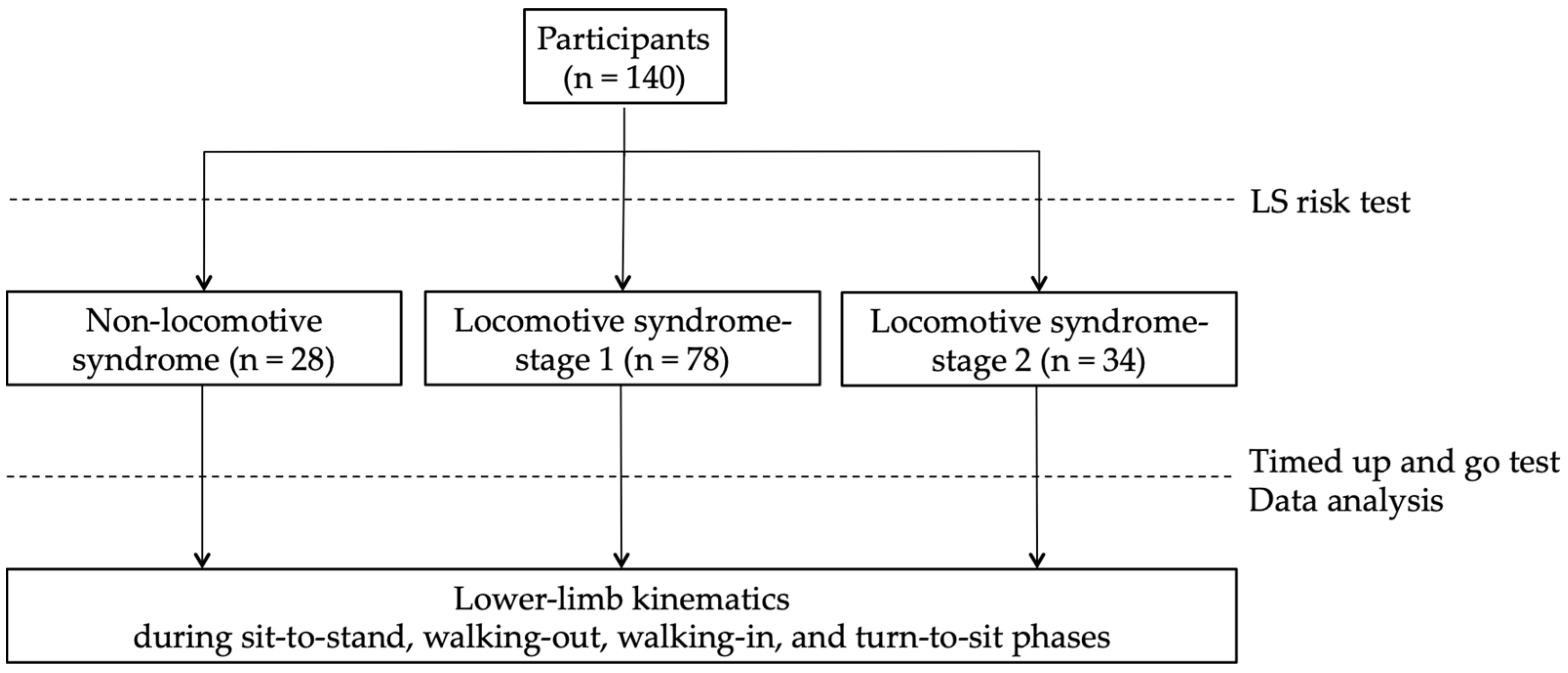

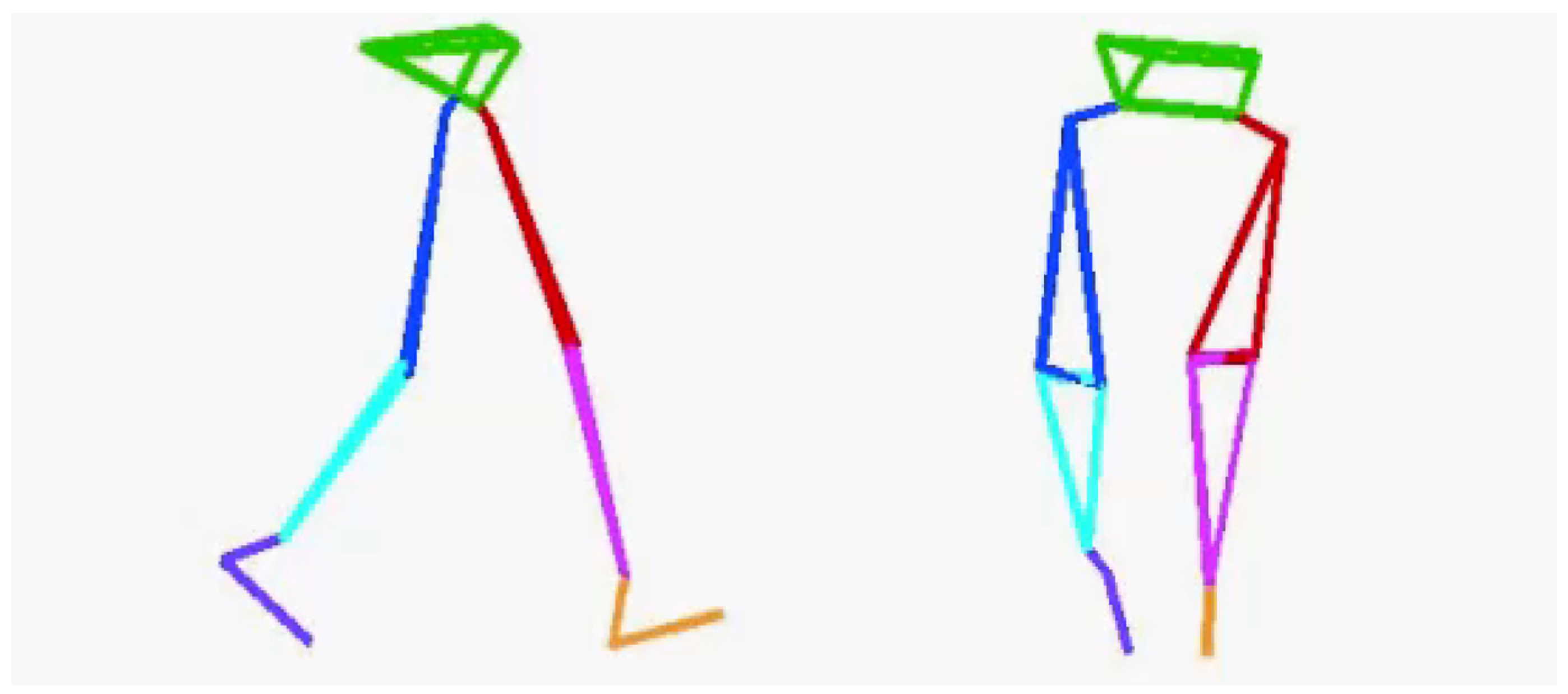
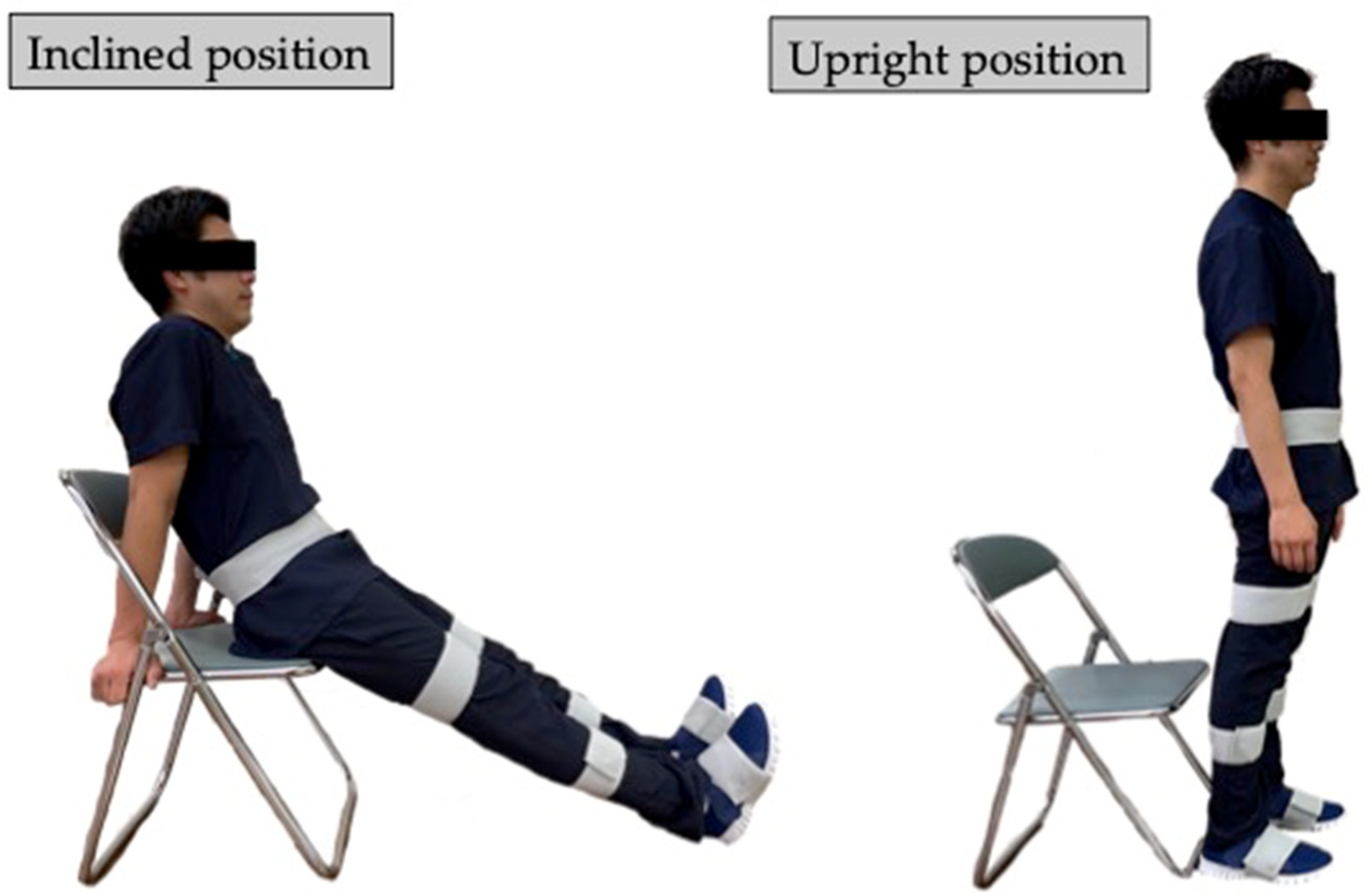
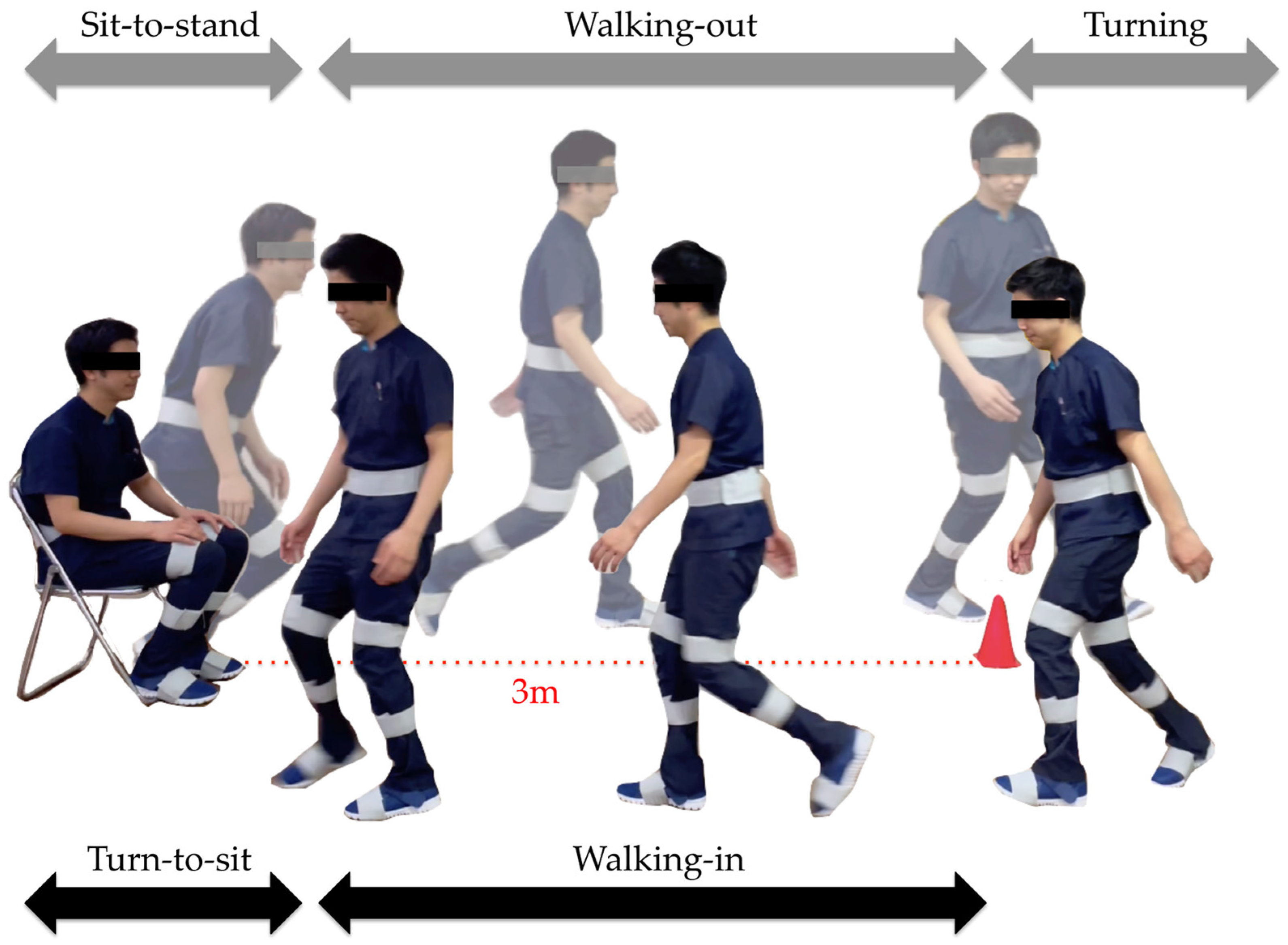
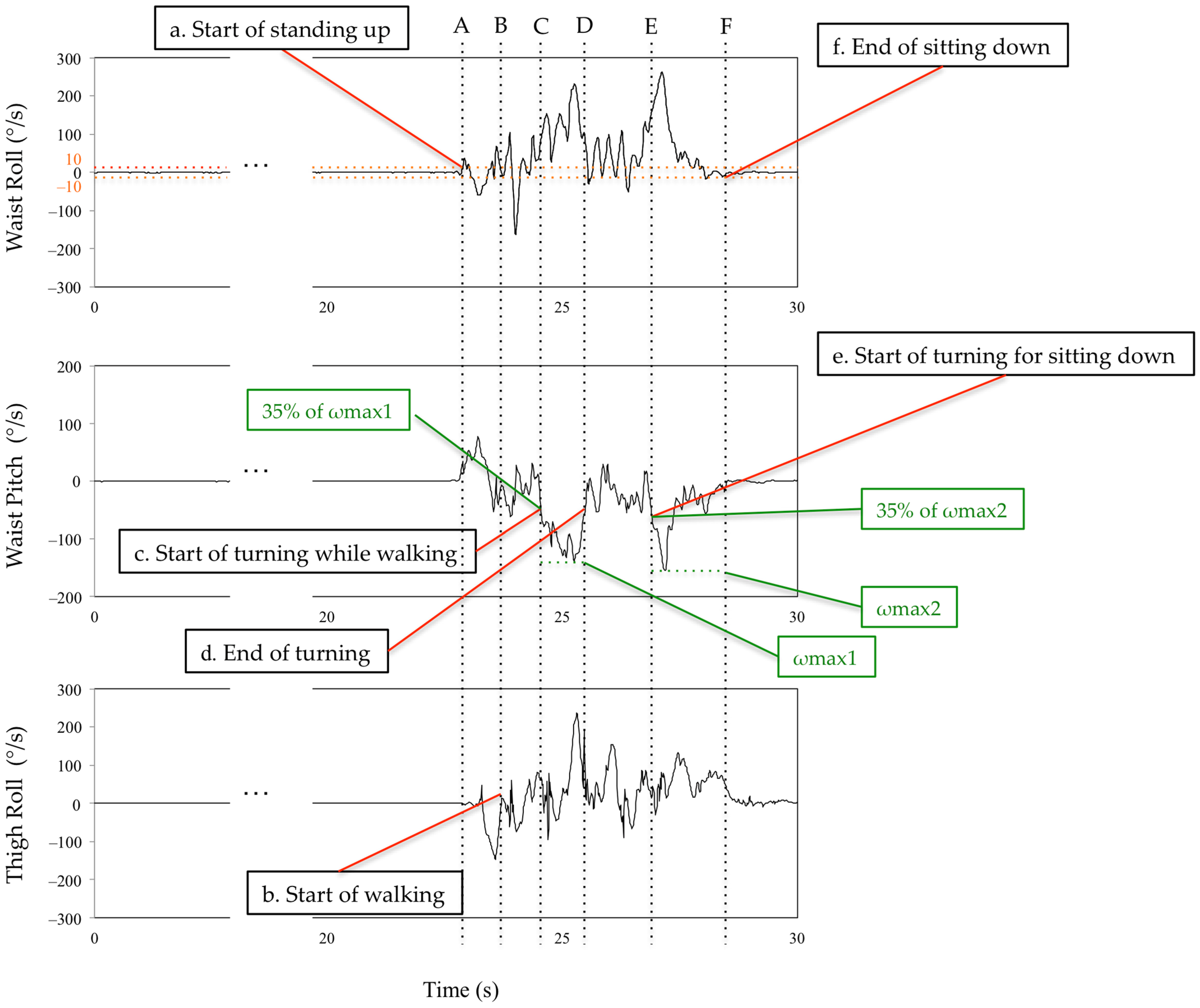

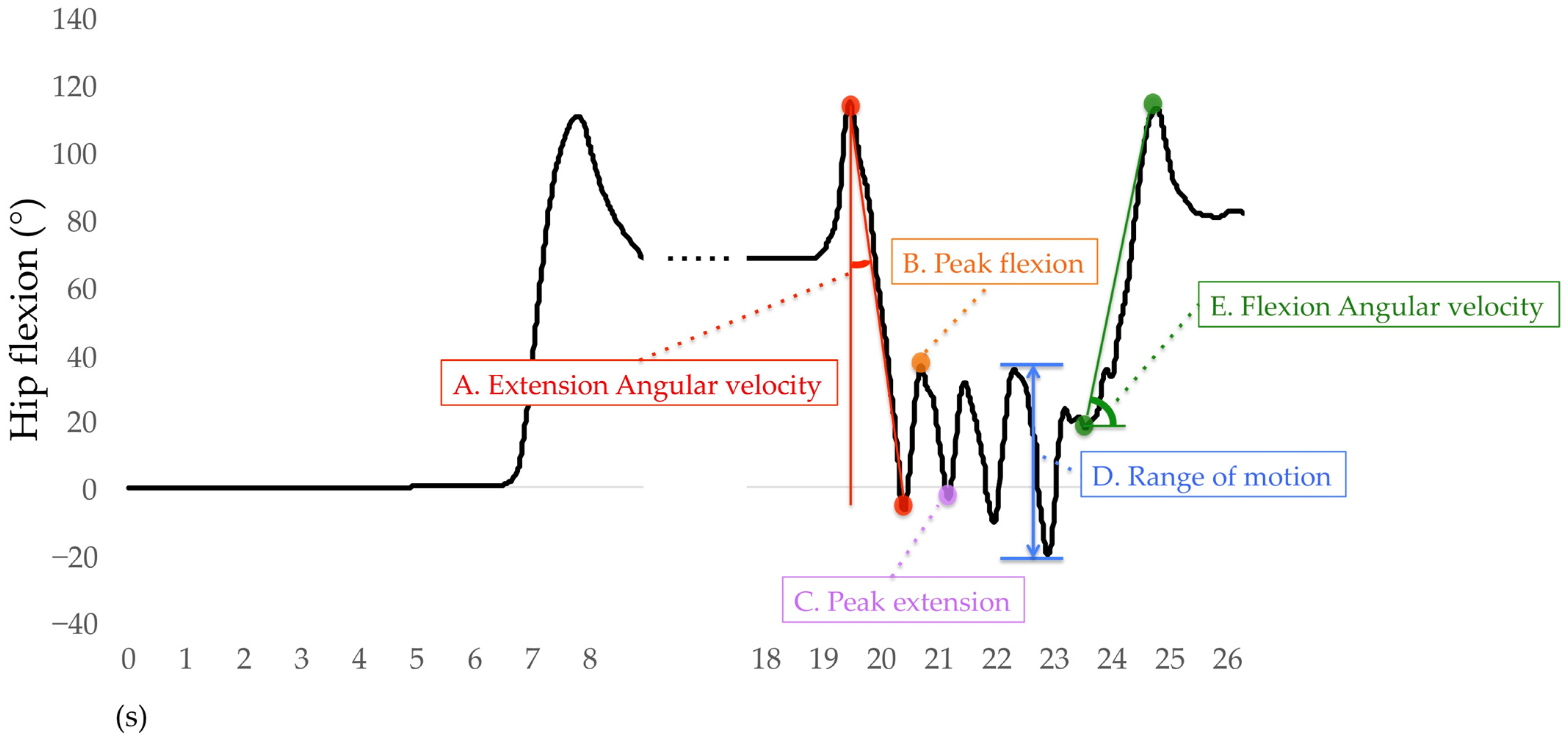
| Non-LS (n = 28) | LS-Stage 1 (n = 78) | LS-Stage 2 (n = 34) | p Value | |
|---|---|---|---|---|
| Age (years) | 69.3 (5.3) | 73.4 (7.0) * | 73.7 (6.7) * | 0.012 |
| Gender (men/women) | 4/24 | 15/63 | 3/30 | 0.375 |
| Height (cm) | 151.5 (7.2) | 153.9 (7.2) | 150.8 (7.1) | 0.072 |
| Mass (kg) | 50.7 (8.0) | 54.3 (7.4) | 53.7 (10.5) | 0.162 |
| TUG completion time (s) | 5.5 (0.9) | 6.4 (1.2) * | 7.4 (1.6) *,# | <0.001 |
| Subtasks | Non-LS (n = 28) | LS-Stage 1 (n = 78) | LS-Stage 2 (n = 34) | p Value |
|---|---|---|---|---|
| Sit-to-stand (s) | 0.5 (0.2) | 0.6 (0.2) | 0.7 (0.3) | 0.210 |
| Walking-out (s) | 1.3 (0.4) | 1.5 (0.4) | 1.6 (0.4) | 0.467 |
| Turning (s) | 0.8 (0.2) | 1.4 (0.6) | 1.6 (0.9) | 0.098 |
| Walking-in (s) | 0.7 (0.2) | 1.0 (0.3) | 1.2 (0.8) | 0.087 |
| Turn-to-sit (s) | 1.3 (0.4) | 2.1 (0.8) | 2.2 (0.9) | 0.251 |
| Subtasks | Kinematics | Non-LS (n = 28) | LS-Stage 1 (n = 78) | LS-Stage 2 (n = 34) | p Value |
|---|---|---|---|---|---|
| Sit-to-stand | Hip extension angular velocity (°/s) | 134.0 (33.4) | 116.3 (29.1) * | 91.7 (23.7) *,# | <0.001 |
| Knee extension angular velocity (°/s) | 113.3 (31.0) | 96.8 (29.9) * | 75.5 (21.7) *,# | <0.001 | |
| Ankle plantar flexion angular velocity (°/s) | 76.8 (46.7) | 72.2 (53.7) | 74.8 (79.0) | 0.421 | |
| Walking-out | Peak hip flexion (°) | 43.1 (10.8) | 39.8 (10.9) | 36.5 (8.4) * | 0.045 |
| Peak hip extension (°) | 1.9 (7.6) | 0.9 (6.6) | −2.6 (6.7) * | 0.019 | |
| Peak knee flexion (°) | 76.6 (13.5) | 69.9 (16.4) | 61.8 (16.7) *,# | 0.002 | |
| Peak knee extension (°) | 2.0 (2.6) | 2.0 (2.9) | 2.2 (2.4) | 0.704 | |
| Peak ankle dorsiflexion (°) | 13.7 (11.2) | 13.6 (11.7) | 12.7 (13.1) | 0.918 | |
| Peak ankle plantar flexion (°) | 15.5 (11.8) | 14.9 (11.1) | 16.8 (12.3) | 0.711 | |
| Walking-in | Hip range of motion (°) | 46.3 (15.5) | 42.2 (13.7) | 36.8 (12.8) | 0.051 |
| Knee range of motion (°) | 59.2 (13.6) | 54.4 (12.7) | 50.8 (14.0) * | 0.027 | |
| Ankle range of motion (°) | 30.4 (20.4) | 29.0 (14.8) | 30.2 (21.3) | 0.908 | |
| Turn-to-sit | Hip flexion angular velocity (°/s) | 97.5 (19.5) | 94.1 (23.6) | 81.5 (25.4) *,# | 0.012 |
| Knee flexion angular velocity (°/s) | 82.9 (28.8) | 79.0 (37.2) | 71.1 (29.7) | 0.364 | |
| Ankle dorsiflexion angular velocity (°/s) | 76.8 (46.7) | 72.2 (53.7) | 74.9 (59.2) | 0.935 |
Disclaimer/Publisher’s Note: The statements, opinions and data contained in all publications are solely those of the individual author(s) and contributor(s) and not of MDPI and/or the editor(s). MDPI and/or the editor(s) disclaim responsibility for any injury to people or property resulting from any ideas, methods, instructions or products referred to in the content. |
© 2023 by the authors. Licensee MDPI, Basel, Switzerland. This article is an open access article distributed under the terms and conditions of the Creative Commons Attribution (CC BY) license (https://creativecommons.org/licenses/by/4.0/).
Share and Cite
Kataoka, Y.; Saito, Y.; Takeda, R.; Ishida, T.; Tadano, S.; Suzuki, T.; Nakamura, K.; Nakata, A.; Osuka, S.; Yamada, S.; et al. Evaluation of Lower-Limb Kinematics during Timed Up and Go (TUG) Test in Subjects with Locomotive Syndrome (LS) Using Wearable Gait Sensors (H-Gait System). Sensors 2023, 23, 687. https://doi.org/10.3390/s23020687
Kataoka Y, Saito Y, Takeda R, Ishida T, Tadano S, Suzuki T, Nakamura K, Nakata A, Osuka S, Yamada S, et al. Evaluation of Lower-Limb Kinematics during Timed Up and Go (TUG) Test in Subjects with Locomotive Syndrome (LS) Using Wearable Gait Sensors (H-Gait System). Sensors. 2023; 23(2):687. https://doi.org/10.3390/s23020687
Chicago/Turabian StyleKataoka, Yoshiaki, Yuki Saito, Ryo Takeda, Tomoya Ishida, Shigeru Tadano, Teppei Suzuki, Kentaro Nakamura, Akimi Nakata, Satoshi Osuka, Satoshi Yamada, and et al. 2023. "Evaluation of Lower-Limb Kinematics during Timed Up and Go (TUG) Test in Subjects with Locomotive Syndrome (LS) Using Wearable Gait Sensors (H-Gait System)" Sensors 23, no. 2: 687. https://doi.org/10.3390/s23020687
APA StyleKataoka, Y., Saito, Y., Takeda, R., Ishida, T., Tadano, S., Suzuki, T., Nakamura, K., Nakata, A., Osuka, S., Yamada, S., Samukawa, M., & Tohyama, H. (2023). Evaluation of Lower-Limb Kinematics during Timed Up and Go (TUG) Test in Subjects with Locomotive Syndrome (LS) Using Wearable Gait Sensors (H-Gait System). Sensors, 23(2), 687. https://doi.org/10.3390/s23020687






